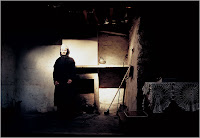
Lebbeus Woods is an American Artist who envisions experimental environments rather than designing practical buildings, comparing his work to the visionary power of cinema. He was quoted saying "the interplay of metrical systems establishing boundaries of materials and energetic forms is the foundation of a universal science (universcience) whose workers include all individuals...."
The majority of his explorations deal with the design of systems in crisis: the order of the existing being confronted by the order of the new. His designs are politically charged and provocative visions of a possible reality, provisional, local and charged with the investment of their creators. He is best known for his proposals for San Francisco, Havana and Sarajevo included in the publication of Radical Reconstruction in 1997. Sarajevo after its civil war, Havana in the grips of the ongoing trade embargo, and San Francisco after the Loma Prieta Eartnquake. Woods studied architecture at the University of Illinois and engineering at Purdue University and first worked in the offices of Eero Saarinen, but in 1976 turned exclusively to theory and experimental projects.
He is currently a professor of architecture at the Cooper Union in New York City. In 1998 Woods co-founded RIEA, the Research Institute for Experimental Architecture, a non-profit institution devoted to the advancement of experimental architectural thought and practice while promoting the concept and perception of architecture itself.
Architecture and war are not incompatible. Architecture is war. War is architecture. I am at war with my time, with history, with all authority that resides in fixed and frightened forms. I am one of millions who do not fit in, who have no home, no family, no doctrine, no firm place to call my own, no known beginning or end, no "sacred and primordial site." I declare war on all icons and finalities, on all histories that would chain me with my own falseness, my own pitiful fears. I know only moments, and lifetimes that are as moments, and forms that appear with infinite strength, then "melt into air." I am an architect, a constructor of worlds, a sensualist who worships the flesh, the melody, a silhoutte against the darkening sky. I cannot know your name. Nor you can know mine. Tomorrow, we begin together the construction of a city.





